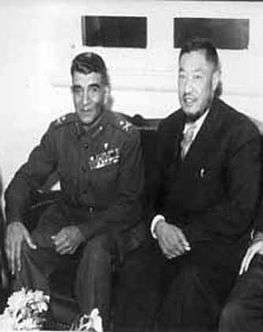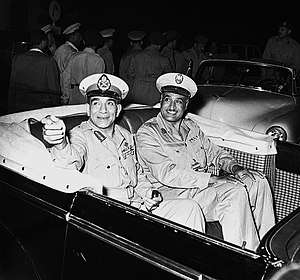Mohammed Naguib
| Mohamed Naguib محمد نجيب | |
|---|---|
 | |
| 1st President of Egypt | |
|
In office 18 June 1953 – 14 November 1954 | |
| Prime Minister |
Himself Gamal Abdel Nasser |
| Preceded by | Fuad II (as King of Egypt and the Sudan) |
| Succeeded by | Gamal Abdel Nasser |
| 30th Prime Minister of Egypt | |
|
In office 8 March 1954 – 18 April 1954 | |
| President | Himself |
| Preceded by | 1st President of Egypt |
| Succeeded by | Gamal Abdel Nasser |
|
In office 17 September 1952 – 25 February 1954 | |
| Monarch | Fuad II (until 18 June 1953) |
| President | Himself (from 18 June 1953) |
| Preceded by | Ali Maher |
| Minister of War and Navy | |
|
In office 17 September 1952 – 18 June 1953 | |
| Prime Minister | Himself |
| Preceded by | Ali Maher |
| Succeeded by | Abdel Latif Boghdadi |
| Personal details | |
| Born |
19 February 1901 Khartoum, Anglo-Egyptian Sudan |
| Died |
28 August 1984 (aged 83) Cairo, Egypt |
| Cause of death | Liver cirrhosis |
| Nationality | Egyptian |
| Political party | Military/Liberation Rally |
| Spouse(s) | Aziza M. Labib (died in 1971) |
| Awards |
Order of Nile Order Egypt |
| Signature |
|
| Military service | |
| Allegiance |
|
| Service/branch | Egyptian Army |
| Years of service | 1918 - 1954 [1] |
| Rank |
|
| Battles/wars | 1948 Arab-Israeli War |
Mohamed Naguib (Egyptian Arabic: محمد نجيب, Egyptian Arabic pronunciation: [mæˈħæmmæd næˈɡiːb]; 19 February 1901 – 28 August 1984) was the first President of Egypt, serving from the declaration of the Republic on 18 June 1953 to 14 November 1954. Along with Gamal Abdel Nasser, he was the primary leader of the Egyptian Revolution of 1952, which ended the rule of the Muhammad Ali Dynasty in Egypt and Sudan.
Early life
On 19 February 1901, Naguib was born as Mohamed Naguib Yousef Qotp Elkashlan in Khartoum, Anglo-Egyptian Sudan. Naguib's father was Youssef Naguib.[2] Sudan was united with Egypt under British occupation at the time. Naguib was the eldest of nine children. Naguib's father was a notable officer of the Egyptian Army. Naguib's mother was Zohra Ahmed Othman, a Sudanese Arab. His family name, "Elkashlan," was very popular in Egypt at that time. Naguib came from a long line of army officers, where his father and uncles all served in the Egyptian Army.
Education
Naguib first studied to become a translator, and later in his life earned a law degree, a Master of Arts degree (MA) in political science and another MA in civil law. He never completed his doctorate because his career in the army, undertaken in defiance of his father's wishes, by then had begun to take off. Nevertheless, he found the time to polish his language skills, learning English, French, Italian and German. Naguib also began to study the revived Hebrew language in the 1950s, and soon after the Revolution he ordered that Hebrew be taught at military college and at Cairo and Alexandria universities, realising that the Egyptian Army had been handicapped during the 1948 Arab-Israeli War by the fact that very few soldiers could interpret Israeli military communications.
While studying in Khartoum, Naguib had often been censured and sometimes even whipped by his British tutors for criticizing Britain's occupation of Egypt and Sudan. At this time, Naguib chose French Emperor Napoleon as a role model, even deciding to sleep on the floor instead of on a bed to imitate the great French general. Soon, however, Napoleon was replaced in Naguib's affections by Mustafa Kamil, the founder of the National Democratic Party, and later he found another mirror in Saad Zaghlul. Some years after he was ousted from power, Naguib also came to somewhat admire Mohandas Gandhi of India.
After the death of his father in 1916, the family moved to Cairo, while Naguib and Ali finished their studies in Sudan.
Military career
Naguib worked as a guard in Cairo, but in 1924, he was moved again because of a political association deemed unacceptable by the authorities. He married in 1927, pursuing his legal studies while continuing a career in the army. By 1931, he was ready to resign from the army, but as a result of an unexpected promotion he decided to turn his attention to his military career once again.
In 1934, he remarried and was transferred to the Egyptian Coast Guard, where he was employed to chase smugglers across the Sinai desert, mixing with the bedouin and helping treat their illnesses. In 1940, he was again promoted. However, despite generally favorable relations between Naguib and King Farouk, Naguib refused to kiss the king's hand. A brisk hand shake was the best Naguib could offer.
Meanwhile, Naguib had continued to climb the military ladder, serving in Palestine during the First Arab-Israeli War in the British Mandate of Palestine in 1948.[2] While on active service in Palestine, Naguib would dedicate 30 minutes every morning to reading the Qur'an, the holy scriptures of Islam, a habit he picked up in childhood, to strengthen his resolve in times of adversity.
Free Officers Movement
In 1949, Naguib secretly joined the Free Officers movement, and a year later he was promoted to the rank of Major-General. The general is considered one of Egypt's few heroes from the war in Palestine and enjoyed wide respect in the country. The Free Officers, led by Colonel Gamal Abdel Nasser were young members of the military – all under thirty-five and all from peasant or lower-middle-class backgrounds. Nasser's goal was to overthrow King Farouk and end the British domination of Egypt and Sudan. Knowing that officers of such youth would not be taken seriously, he asked General Naguib to assume leadership of the movement. While this proved successful in strengthening the Free Officers, it would later cause great friction between the two men. Despite his disapproval of his fellow military top brass, Naguib remained in the army in order for the Free Officers not to lose their highest-ranking officer and most influential member, although many today argue that his position on the top was merely a figurehead leader to the revolutionary Free Officers Movement to lend credibility to the group.
Revolution of 1952

On 23 July 1952, the Free Officers commenced the Egyptian Revolution of 1952 with a coup d'état to depose King Farouk. Naguib was appointed, first as Commander-in-Chief of Army, in order to keep the armed forces firmly behind the junior officers' coup. In September, Naguib was appointed Prime Minister of Egypt and a member of the Royal Regent Council, with Nasser serving in the background as Minister of the Interior.
Naguib was at the forefront of the Free Officer's movement, lending it legitimacy in the eyes of the people, the army, politicians and foreign powers. Within 24 hours of the beginning of the revolution, the newly formed Revolution Command Council (RCC) had asserted that their movement's peaceful intentions, with Naguib as its leader. Naguib's was a familiar name at the time, unlike those of the other Free Officers, who were too young and too junior in rank to have made a name for themselves.
The succession of Fuad II was designed to deny the British a pretext for intervention, allowing the revolutionaries to maintain that they were opposed only to the corrupt regime of Farouk, not to the monarchy itself. However, after consolidating their power, they quickly moved to implement their long-held plans for abolishing the monarchy and the aristocracy. Ali Maher's government resigned on 17 September 1952 and Naguib was appointed Prime Minister. On 18 June 1953, almost 11 months after the revolution, Naguib declared the end of the Egyptian and Sudanese monarchy and the establishment of the Republic of Egypt.
Presidency
With the declaration of the Republic, Naguib was sworn in as its President. At this time, Naguib had become simultaneously the president, the prime minister and chairman of the RCC and forming a government mostly composed of army officers. Nasser became deputy prime minister, and it was already apparent that he had a strong grip on domestic affairs. However, Naguib remained the most senior officer in the government and the national leader of the country and of the RCC, even as a struggle for power was brewing.
In late 1953, however, Nasser accused Naguib of supporting the recently outlawed Muslim Brotherhood and of harbouring dictatorial ambitions. A brief power struggle broke out between Naguib and Nasser for control of the military and of Egypt. Nasser ultimately won the struggle and managed to force Naguib to resign from the presidency of Egypt in November 1954.
 Naguib (left) and Gamal Abdel Nasser during celebrations for the second anniversary of the revolution, July 1954
Naguib (left) and Gamal Abdel Nasser during celebrations for the second anniversary of the revolution, July 1954 Naguib, in front of his portrait, in the last days of his life
Naguib, in front of his portrait, in the last days of his life Last declaration by Mohamed Naguib before his arrest 1954
Last declaration by Mohamed Naguib before his arrest 1954
After the Presidency
Following his resignation, Naguib was then isolated by President Nasser in a suburban Cairo villa owned by Zienab Al-Wakil, wife of Mustafa El-Nahas, former Prime Minister of Egypt. Naguib was released from his isolation in 1972 by President Anwar Sadat.
Personal life
On 28 August 1984, Naguib died from liver cirrhosis in Cairo, Egypt. He was 83. Naguib had a military funeral that was attended by President Hosni Mubarak.
Legacy
In 1984, his memoirs were published under the title I was a President of Egypt. The book was reprinted several times and was also translated into English under the title The Fate of Egypt. A station of the Cairo Metro is named in his honour. A major road in the Al Amarat District of Khartoum is also named after him.
In December 2013, Interim President Adly Mansour awarded the Order of the Nile, the highest state honour; to the name of the late President Naguib. The award was received by his son, Mohamed Yusuf ibn Mohamed Naguib.
See also
Further reading
- Muhammad Naguib, Egypt's Destiny (London, 1955)
External links
| Wikimedia Commons has media related to Mohammed Naguib. |
References
- ↑ "ذاكرة مصر المعاصرة - السيرة الذاتية". Modern Egypt. Retrieved 22 December 2012.
- 1 2 "Muhammad Naguib". Encyclopedia Britannica. Retrieved 22 December 2012.
| Political offices | ||
|---|---|---|
| Preceded by Fouad II as King of Egypt and the Sudan |
Head of state of Egypt 1953–1954 |
Succeeded by Gamal Abdel Nasser |
| New title |
President of Egypt 1953–1954 |
Succeeded by Gamal Abdel Nasser |
| Preceded by Ali Maher |
Prime Minister of Egypt 1952–1954 |
Succeeded by Gamal Abdel Nasser |